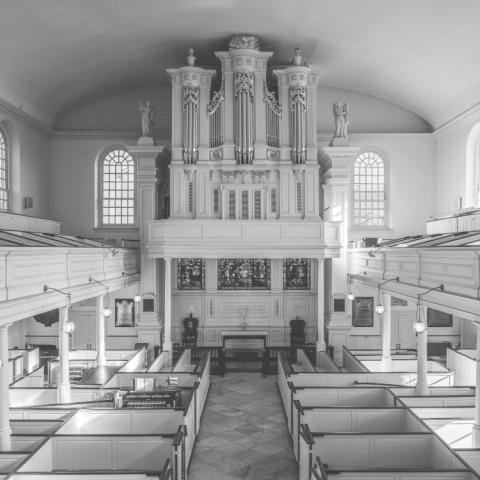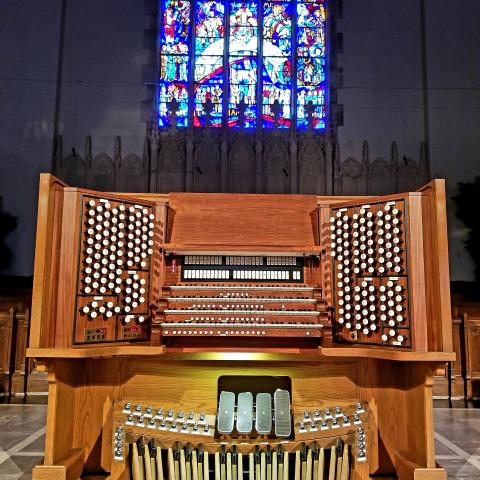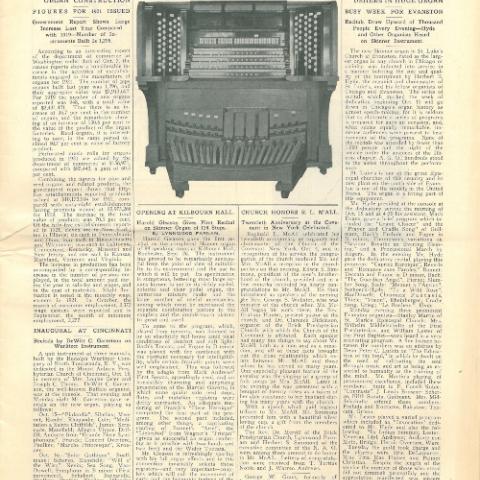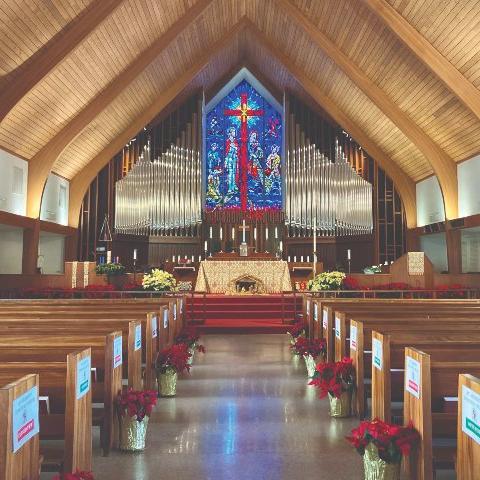A. Thompson-Allen Company, New Haven, Connecticut; Derry Presbyterian Church, Hershey, Pennsylvania

Editor's note: Click on the link above to view the front cover of the April 1951 issue of The Diapason and announcement of Opus 1132 for the Church of the Redeemer, New Haven, Connecticut.
The organ’s first career
In 1951 New Haven’s Church of the Redeemer, founded in 1838, moved into a neo-colonial structure designed by prominent local architect Douglas Orr. The new church was located in the city’s East Rock neighborhood and quickly took its place among Orr’s other distinguished buildings that remain popular to the present day.
The church’s organist-choirmaster, Hope Leroy Baumgartner (1891–1969), was assigned the task of designing a suitable organ for the new sanctuary. A student of Horatio Parker and Harry Benjamin Jepson, Baumgartner was awarded a Bachelor of Music degree from the Yale School of Music in 1916. In 1919 he was appointed to the faculty as an associate professor where he taught composition and music theory with distinction until his retirement in 1960.
As a teacher, Baumgartner was famous for his attention to detail, so it is no surprise that he took an intense interest in the designing of Church of the Redeemer’s new organ, to be built by the Aeolian-Skinner Organ Company as their Opus 1132. The April 1951 issue of The Diapason carries a front-page article describing the completion of the new organ, noting:
The organ was designed by H. Leroy Baumgartner, organist and choirmaster of the church, associate professor of the theory of music at Yale University and noted composer. Professor Baumgartner spent several years developing the scheme for this instrument and provided detailed instructions for its construction, which included drawings specifying the placement of the controls at the console. A feature of the organ will be an unusually large number of mechanical controls, some of which were designed by Professor Baumgartner.
Baumgartner was especially known for accompanying oratorios as part of his music program, and he wanted an instrument that would facilitate complex registrational changes. Not only did he specify several highly unusual console controls, but he also had some idiosyncratic ideas about the design of the stoplist.
The founder of our company, Aubrey Thompson-Allen, was assistant to G. Donald Harrison while Opus 1132 was being negotiated. Harrison had become exasperated with Baumgartner’s incessant micromanaging of the details of the organ’s stoplist and console controls, ultimately placing a large stack of correspondence in Aubrey’s hands and asking him to go to New Haven to see if the contract somehow might be finalized and signed. Ultimately it was, and an order was given for an instrument of fifty-one speaking stops controlled by a three-manual console, with a floating Positive division that could be played from the Great or Choir manuals.
In an effort to wring the greatest number of stops from the complement of pipes, a number of compromises had to be made. To cite only one example, the 8′ Rohr Bordun in the Swell served also as the unison flute for the Great, Choir, and Pedal divisions, which had none of their own. To save expense, the design of the organ omitted the use of chest relays, with the result that this flute would not “travel” with any of the couplers and had to be drawn separately on any manual to which the Swell might be coupled.
For more than sixty-five years, Opus 1132 provided reliable and beautiful music under the hands of several musicians. Each of them learned to accommodate the organ’s peculiarities, including an amazingly complicated setterboard that controlled the combination pistons. The members of the Church of the Redeemer cherished their Aeolian-Skinner organ and maintained excellent stewardship of it, including a basic releathering of the chassis and the installation of a multi-level combination action in 2007, even as the congregation was beginning to contemplate its own future.
By 2018 the membership had dwindled to about 170 dedicated people, and they found it increasingly difficult to keep their large physical plant maintained to the standards they had set for themselves. After exploring possible mergers with other Congregational churches in the area, the members voted to close the church and sell the property, ending Redeemer’s 180-year history of service to New Haven. Consistent with the congregation’s strong commitment to its core values, more than $2.2 million was donated to other churches and entities having similar values and missions, including almost $800,000 set aside as the Church of the Redeemer Community Legacy Fund at the Community Foundation for Greater New Haven.
Unable to find a buyer willing to continue the building’s use as a church, after two years the congregation sold the property to a developer for conversion to apartments, with the stipulation that the external appearance of the church and its parish house would be preserved as a neighborhood landmark. The organ was offered for sale, and while several church delegations were enthusiastic about the instrument, none of them could undertake the project. As the deadline for interior demolition approached, the organ’s fate looked increasingly uncertain. Those who knew and loved Opus 1132 became anxious for the organ’s future.
In late September 2019, a committee from Derry Presbyterian Church in Hershey, Pennsylvania, which had been searching for an Aeolian-Skinner organ, heard about Opus 1132’s availability, and on October 4 visited Church of the Redeemer. Yale Institute of Sacred Music student Jerrick Cavagnaro engagingly demonstrated the instrument for the committee, and it was love at first sight. They were impressed by the organ’s musical qualities and excellent state of preservation, and in short order, contracts were drawn up and signed. On November 3 a farewell concert was played by several prominent local musicians, with members of the Derry Presbyterian Church present to formally receive the instrument. Removal of the organ began immediately afterwards, just as construction equipment started to appear on the property.
—Joseph F. Dzeda
Restoration and relocation of Opus 1132
The restoration of this fine Aeolian-Skinner was perfectly straightforward for us as we have restored a number of Skinner and Aeolian-Skinner organs over the last fifty years. After we removed the organ from Church of the Redeemer we proceeded to complete the restoration. We had releathered the organ ten years earlier, but this did not include restoration of the pipework and new gaskets for all the chests and windlines.
The flue pipes were cleaned, repaired, and fitted with new stainless slide tuners. The wood flutes were cleaned and shellacked, with the stoppers releathered. Then each stop was placed on my voicing machine to be regulated for power and speech. The wind pressures were reset to the factory records. All the pitman and unit chests had been fully rebuilt and were in perfect condition. Anything that was not done during the previous work was now completed, including new gaskets for all the pitman and unit chests and assorted windline flanges.
The original console and all relays and wiring were replaced. The old console was painted and was unsuitable to go with the other woodwork in the church. A new oak console with Peterson solid-state was built by Organ Supply Industries and was matched to the existing furniture in the new location. We made every attempt to replicate the appearance of an Aeolian-Skinner console, especially with knob, coupler, and piston layout.
We wanted to restore the organ tonally to the way that G. Donald Harrison had originally designed it. In the final specification the organ did not contain unison flutes on the Great, Choir, and Pedal. The unit Swell 16′ Rohr Bordun had to do the job on all manuals and pedal. GDH was dead set against this, and he eventually put the project in Aubrey Thompson-Allen’s (assistant to GDH) hands.
We have endeavored to complete the specification with the addition of:
• A new Skinner-style Choir 8′ Concert Flute.
• A repurposed 1930 Skinner Great 8′ Flute Harmonique.
• A repurposed Pedal 16′–8′ Bourdon, retained from the Hershey church’s former Reuter organ.
In its previous home the Pedal Bombarde was buried in a tone pocket in the Choir organ and was ineffective. We have relocated it, unenclosed, with the Pedal division just behind and slightly above the Great division. It is a fine “English Trombone” and is very successful in its new location. This and all of the other reeds in the organ have been beautifully restored by Broome and Company.
Relocating the organ designed for a completely different organ chamber presented many challenges, especially as Opus 1132 is much larger than the former organ. The entire organ was reconfigured and assembled in our erecting room. The organ had originally been installed either side of the chancel with the Choir, Positive, and Pedal on one side and the Swell and Great on the other. There were always pitch issues with the Great and Positive being in different locations, and it could be perilous to combine them!
The new chamber has the Swell and Choir in identical swell boxes on either side of the chamber, with vertical shutters on the front and diagonally on the sides, with the shades angled to project the sound out into the church. The Great and Positive, which are on chromatic chests, are installed next to each other with the treble end facing the chamber opening and passage boards between the chests for tuning access. This has eliminated the pitch differences that had existed. The entire organ is on one level except for the Great and Pedal zinc basses that had been in the façades of the Redeemer organ. These were cut to speaking length and placed on new chests above the Great and Positive. Aeolian-Skinner often did this when space was at a premium.
The Pedal organ has been placed at the back of the main chamber starting with the 16′ Contra Bass and continuing forward with the 16′ Bourdon and then the 16′ Bombarde. The mouths are at different heights to ensure adequate speaking room, and every effort has been made to have all of the windchests accessible for maintenance.
The entire wind trunk system is made up of either new galvanized metal or the original windlines unsoldered and reconfigured as needed. All of the Aeolian-Skinner flanges were retained.
The original Spencer blower was retained and restored by Joseph Sloane. The hubs and turbine fans had been badly damaged when the fans were removed to service the motor in the past. New fans and hubs had to be manufactured and installed, and the old single-phase induction motor was replaced with a new three-phase motor. We have found the single-phase motors to be unreliable after 70–100 years and warrant replacement for safety and reliability. Also, the blower never had a static reservoir, instead having a small Spencer pressure regulator. Not only did this have inadequate capacity, but it also allowed wind noise into the chamber through the windlines, caused by fan turbulence. We have installed a vintage Skinner reservoir over the blower to overcome these issues. Now up in the chamber the organ is silent with the wind on.
This very rewarding project was completed by the following members of the ATA Company:
• Kurt Bocco—reservoirs, wind trunks and installation.
• Joseph Dzeda—wiring and keeping the company in order during our many weeks away.
• Joe Linger—all windchests and installation.
• Sam Linger—all windchests and installation.
• Nick Thompson-Allen—pipe restoration and voicing and installation and tuning.
• Nate Ventrella—wiring and installation.
• Zack Ventrella—layout, console and wiring, installation, and tuning.
Also, we thank:
• Chris Broome—all reed pipe restoration.
• Joseph Sloane—blower restoration and installation.
• Bryan Timm and Organ Supply Industries—new console, new Peterson solid-state, new chests for the Great and Pedal basses and the two added stops, and the new pipes for the Concert Flute.
And finally:
• Grant Wareham—organist and liaison with the church, whose help and patience have been greatly appreciated.
—Nicholas Thompson-Allen
The musician’s perspective
Opus 1132 is a wonderful instrument. It is ideal for all types of choral accompanying, fills the room well for congregational singing, and can tackle almost any type of organ repertoire.
All five divisions are exceedingly useful and come together for an excellent chorus. The Swell gives everything I would expect from an Aeolian-Skinner Swell division, and the 16′ Clarinet doubles beautifully as a color reed. I’ve also found that removing the mixture and super-coupling the division into the chorus works very well for a “chorus-crowning” brilliance.
The addition of the Harmonic Flute gives added strength to an already-strong Great division. Similar in scale to the Principal Flute on the Newberry Memorial Organ at Woolsey Hall, it serves as a subtle third diapason from midrange down and scintillates impeccably in the soprano range. The rich, warm Montre and firm Diapason complement each other perfectly. The 2′ and Quint can serve as an alternate mixture before adding the Fourniture to crown the chorus.
A pair of Erzhälers on the Choir give the signature light Skinner string shimmer and are exceedingly useful for quiet moments either in repertoire or in services. The Koppelflöte and new Concert Flute make a beautiful pair and blend nicely with the Viola. The English Horn is predictably delectable. With a non-mounted cornet and a sparkling Cymbal, the Positive rounds out the organ nicely.
The Bombarde is at its best in the Pedal—it’s an excellent, present reed at both 8′ and 16′ pitch. The addition of the 16′ Bourdon, from the Reuter instrument (Opus 1499) previously installed in the space, rounds out the bass end of the Pedal division beautifully. Adding the 102⁄3′ Quint stop produces a strong 32′ resultant and anchors the organ perfectly.
It was truly a pleasure to work with Nick Thompson-Allen, Joe Dzeda, Zack and Nate Ventrella, Joe and Sam Linger, Kurt Bocco, and everyone at Thompson-Allen, who all worked very hard throughout this project. Through all the challenges this project threw them (including the physical puzzle of putting the pipework in the existing chamber, complex wiring, and pandemic-related delays), they displayed the utmost of professionalism. My thanks as well to Bryan Timm of OSI for the console, which is so close to Aeolian-Skinner specifications, I often forget it is, in fact, brand-new. I feel very lucky to preside over this fine organ.
—Grant Wareham
Total speaking stops: 59
Total ranks: 45
Total pipes: 2,794
Builder’s website: www.thompson-allen.com
Church’s website: www.derrypres.org
Cover photo by Robert J. Polett, Photographer
View a PDF of Opus 1132’s first front cover in The Diapason, April 1951, at the website. Click on the cover feature for the March 2022 issue.
GREAT (3¾″ pressure)
16′ Rohr Bordun (Swell)
8′ Diapason 61 pipes
8′ Montre 61 pipes
8′ Flute Harmonique (1) 61 pipes
8′ Rohr Bordun (Swell)
4′ Octave 61 pipes
2-2⁄3′ Quinte 61 pipes
2′ Super Octave 61 pipes
IV Fourniture 244 pipes
8′ Bombarde (Pedal) 17 pipes
Chimes (in Choir) (2) 20 notes
SWELL (4″ pressure)
16′ Rohr Bordun 68 pipes
8′ Spitz Principal 68 pipes
8′ Rohr Bordun (ext 16′) 12 pipes
8′ Viole de Gambe 68 pipes
8′ Viole Celeste (CC) 68 pipes
4′ Prestant 68 pipes
4′ Holzflöte (3) 68 pipes
2′ Spitzflöte 61 pipes
III Plein Jeu 183 pipes
16′ Bass Clarinet 68 pipes
8′ Trompette 68 pipes
8′ Oboe 68 pipes
8′ Vox Humana (4) 68 pipes
4′ Clarion 68 pipes
Tremulant
POSITIVE (3″ pressure)
8′ Singend Gedeckt 61 pipes
4′ Nachthorn 61 pipes
2-2⁄3′ Nasat 61 pipes
2′ Blockflöte 61 pipes
1-3⁄5′ Terz 61 pipes
1-1⁄3′ Larigot 61 pipes
III Cymbel 183 pipes
CHOIR (4″ pressure)
16′ Erzähler 61 pipes
8′ Viola 68 pipes
8′ Concert Flute (5) 68 pipes
8′ Erzähler (ext 16′) 12 pipes
8′ Kleine Erzähler (TC) 49 pipes
4′ Koppelflöte 68 pipes
4′ Erzähler (ext 16′) 12 pipes
8′ English Horn 68 pipes
Tremulant
8′ Bombarde (Pedal)
PEDAL (5″ pressure)
32′ Resultant (16′ Bourdon, 10-2⁄3′ Rohr Bordun)
16′ Contra Bass 32 pipes
16′ Bourdon (6) 32 pipes
16′ Rohr Bordun (Swell)
16′ Erzähler (Choir)
10-2⁄3′ Quint (from Bourdon)
8′ Principal 32 pipes
8′ Gedeckt (ext Bourdon) 12 pipes
8′ Rohr Bordun (Swell)
8′ Erzähler (Choir)
5-1⁄3′ Quint 32 pipes
4′ Super Octave (ext Princ) 12 pipes
4′ Rohr Bordun (Swell)
16′ Bombarde 32 pipes
16′ Bass Clarinet (Swell)
8′ Bombarde 12 pipes
4′ Bombarde 12 pipes
Chimes (Great)
Notes
(1) 1–12 Organ Supply Industries, 13–61 Skinner Organ Co. 1930, chest by Organ Supply Industries
(2) Old Chimes and action reused by Aeolian-Skinner in 1951
(3) Old Hall Organ Company pipes reused by Aeolian-Skinner in 1951
(4) Skinner & Son pipework, installed in chest preparation, 2007
(5) Pipes and chest by Organ Supply Industries, to Skinner scales
(6) Pedal Bourdon from previous organ by Reuter
2007 - Releathering, multi-level combination action, and addition of Skinner & Son Vox Humana
2020 - Relocation, completion of chassis and pipework restoration, additional stops as noted. Console by Organ Supply Industries, reed pipes restored by Broome and Company, LLC, Spencer Turbine blower restored by Joseph Sloane







